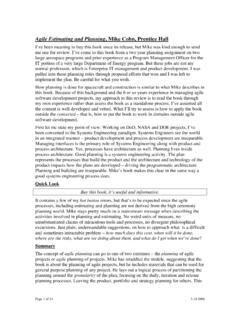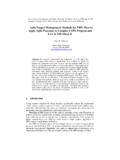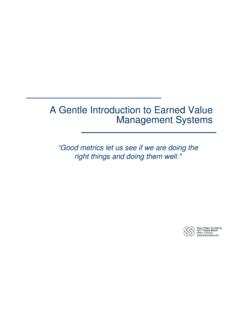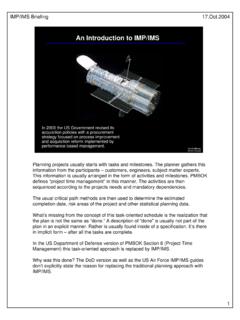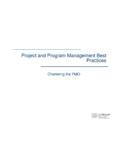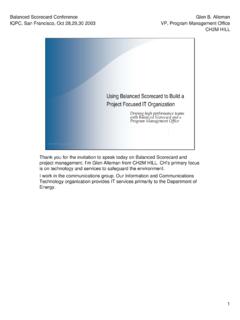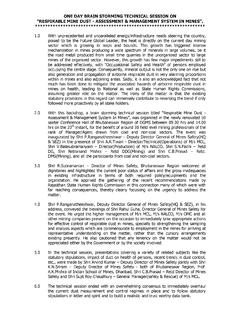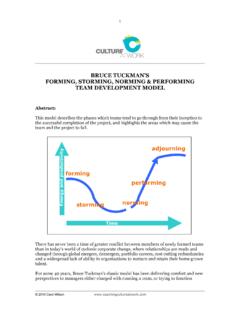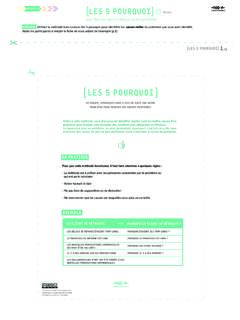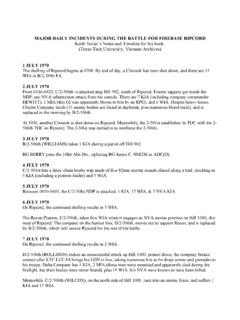Transcription of Forming, Norming, Storming, Performing - Niwot Ridge
1 forming , storming , Norming, Performing and Adjourning Managers are people who do things right, while leaders are people who do the right thing. Warren Bennis, "On Becoming a Leader" Glen B. AllemanNiwot, ColoradoJanuary team has A small numberof people with complementary skillswho are committed to a common purpose, performance goals, and a common approachfor which they hold themselves mutually accountable. forming team members are introduced storming the team transitions from as is to to be Norming the team reaches consensus on the to be process Performing the team has settled its relationships and expectations Adjourning the team shares the improved processes with othersStaged Development of Teams The forming , storming , Norming, Performing stages are seemingly obvious but are in fact difficult. Participants want to move to the Performing stage without passing through the first three stages.
2 The forming stage is relatively easy. The storming stage is difficult and many times the cause of the team s failure. Performing seems easy once the storming process is Development of Teams The Real problem is how to identify when a stage is complete: The team members agree that the stage is complete? The team coach agrees the stage is complete? The team simply moves on to the next stage? The definition of the exit criteria between stages needs to be worked out prior to the team s reaching the end of the stage. This again seems obvious but is also very The polite stage in which the team starts to form. Everyone is trying to figure out what the team concept is. Initial silent leaders may take the rein. The team is usually positive for the most part for the initial meetings. No one has offended anyone at this point yet! forming forming includes feelings and behaviors of: Excitement, anticipation, and optimism.
3 Pride in being chosen for the project. A tentative attachment to the team Suspicion and anxiety about the job. Defining the tasks and how they will be accomplished. Determining acceptable group behavior. Deciding what information needs to be gathered. Abstract discussions of the concepts and issues, and for some members, impatience with these discussions. There will be difficulty in identifying some of the relevant Because there is so much going on to distract members' attention in the beginning, the team accomplishes little, if anything, that concerns it's project goals. This is perfectly normal. Exit Criteria? storming The honeymoon is over. The silent leaders may be clashing for control of the group. People disagree and may blame the team concept, saying it doesn t work. Management needs to do a lot of coaching to get people to work past their differences, may take separate 1 on 1 s with storming includes feelings and behaviors of: Resisting the tasks.
4 Resisting quality improvement approaches suggested by other members. Sharp fluctuations in attitude about the team and the project's chance of success. Arguing among members even when they agree on the real issues. Defensiveness, competition, and choosing sides. Questioning the wisdom of those who selected this project and appointed the other members of the team. Establishing unrealistic goals. Disunity, increased tension, and The above pressures mean that team members have little energy to spend on progressing towards the team's goal. But they are beginning to understand one another. This phase sometimes takes 3 or 4 meetings before arriving at the Norming phase. Exit Criteria?Norming The team is starting to work well together, and has turned around from the storming phase. They may start to brag up the team concept to others who aren t in the team and will be very positive about their role/team group.
5 Often, the team will bounce back and forth between storming and norming when issues crop Regressions will become fewer and fewer and the team will bounce back to norming in a quicker manner as the team matures. The natural leaders at this stage may not be the ones who were visible in stages 1 & 2 (those people may no longer have the unofficial lead roles within the team. This team still takes management direction, but not as much as storming . Norming Norming includes feelings and behaviors of: An ability to express criticism constructively. Acceptance of membership in the team. An attempt to achieve harmony by avoiding conflict. More friendliness, confiding in each other, and sharing of personal problems. A sense of team cohesion, spirit, and goals. Establishing and maintaining team ground rules and boundaries. As team members begin to work out their differences, they now have more time and energy to spend on the project.)
6 Exit Criteria? Performing This is the level where the team is a high performance team. They can be given new projects and tasks and accomplish them successfully, and very seldom fall back into the storming phase. At this level, the team is taking on new work on their own, and selling it to other At this level, the team can usually take on a new member or two with little trouble as far as regressing goes. They are a complete self-directed team and require little, if any, management direction. In many organizations, this can take 6 months or longer to reach this state this Performing includes feelings and behaviors of: Members have insights into personal and group processes, and better understanding of each other's strengths and weakness. Constructive self change. Ability to prevent or work through group problems. Close attachment to the team. The team is now an effective, cohesive unit. You can tell when your team has reached this stage because you start getting a lot of work done.
7 Exit Criteria?Adjourning The team briefs and shares the improved process during this phase. When the team finally completes that last briefing, there is always a bittersweet sense of accomplishment coupled with the reluctance to say good bye. Many relationships formed within these teams continue long after the team disbands. Exit Criteria?Teams versus Work GroupsGroups Individuals establish a set of behaviors called roles. These roles set the expectations governing the relationships between the group members. The search for role definition serves as a source of confusion and and ResponsibilitiesTeams Teams have a shared understanding of how to perform their role. For example: Time keeper Score keeper Leader FacilitatorTeams versus Work GroupsGroups Groups do not have a cohesive identity. It is difficult to establish a sense of cohesion that characterizes a Teams have an identity. A team has a clear understanding about what constitutes the team s work and why it is important.
8 They can describe a picture of what the team needs to achieve, and the norms and values that will guide them. Teams versus Work GroupsCohesionTeams Teams have an esprit that shows a sense of bonding and camaraderie. Esprit is the spirit, soul, and state of mind of the team. It is the overall consciousness of the team that a person identifies with and feels a part of. Individuals begin using we more than me or I. Groups Groups lack a source of cohesion. Being a member of a group still leaves the person alone and an versus Work GroupsGroups Groups tend to get bogged down with trivial issues. FacilitatingTeams Teams use facilitators to keep the team on the right path. Teams versus Work GroupsCommunicationGroups The communications with a group tend to be centered on individuals. Individual positions are more important than a team opinion. Defending ones opinion becomes an end unto The team is committed to open communication.
9 Team members feel they can state their opinions, thoughts, and feelings without fear. Differences of opinion are valued and methods of managing conflict are understood. Through honest and caring feedback, members are aware of their strengths and weaknesses as team members. Teams versus Work GroupsGroups Most groups are extremely rigid. This rigidity is due to many causes: Defense of individual positions Individual reward systems The strengths of each individual is difficult to capitalize on since someone has to give up a role to allow another to assume that Teams, provide flexibility and perform different task and maintenance functions as needed. The responsibility for team development and leadership is shared. The strengths of each member are identified and used. Acknowledgement of Sources This set of slides is a compendium of ideas. Collecting of good ideas and repurposing them seems to add value to new readers who may not have encountered these ideas in the past.
10 The concepts of teaming and the processes of team building can be traced to many authors. John Kotter is one source everyone should consult. Although these ideas appear obvious, they are in fact quite difficult to put into practice.
